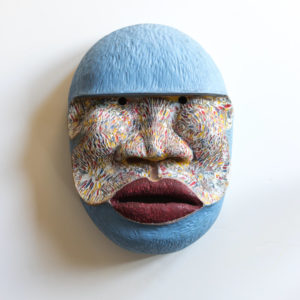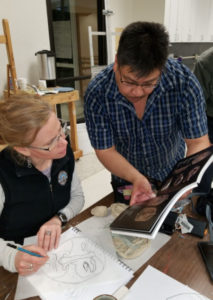 Alaska Native elders and renowned artists Joe and Martha Senungetuk taught Alaska Pacific University students about the tradition, folklore, and craftsmanship associated with Alaska Native masks during a May-term art class.
Alaska Native elders and renowned artists Joe and Martha Senungetuk taught Alaska Pacific University students about the tradition, folklore, and craftsmanship associated with Alaska Native masks during a May-term art class.
The Senungetuk’s were named APU’s inaugural Artists-in-Residence for the heARTS Healing Center and Studio last October. In that role, they’ve held various workshops for those within the APU community to develop their artistic craft and to unwind. This course, however, marked the duo’s first for-credit class. Andrew Abyo, who taught the Kayak Building block course in January, also assisted with the course.
Over the span of the month, the trio helped students identify what style of mask they wanted to pursue, what story their mask would tell, and schooled them in how to go from raw materials to a finished piece.
Vlasoff said they chose to make masks for the art course because it’s an important part of Alaska Native culture.
“Masks were used in dances and ceremonies – it’s a way to express an ancient story of our people and the stories of future generations,” Martha said, adding that the masks are a way for students to “connect with their inner selves.”
 Kaylee Benedixen, one of the students enrolled in the course, said that ethos was often circled back to during. She said, she learned that there “are spiritual and cultural aspects to the carving process. Once you have that kind of connection to a piece of artwork, it’s a beautiful thing.”
Kaylee Benedixen, one of the students enrolled in the course, said that ethos was often circled back to during. She said, she learned that there “are spiritual and cultural aspects to the carving process. Once you have that kind of connection to a piece of artwork, it’s a beautiful thing.”
For Chenita Sorensen, another student in the course, the biggest lessons learned involved understanding that both the planning process and having an established meaning behind the mask are essential for crafting a piece that is both visually appealing and true to tradition.
Over the years, Joe has made a myriad of contemporary and traditional style masks, though he said the ones treasured most are those that tell a story. Recently the Senungetuk’s collaborated on a mask that hung in the International Gallery of Contemporary Art. Titled “The wonder bread effect,” they said their creation “depicts the change from subsistence foods to Western diets, which has led to chronic health problems among Indigenous peoples.”
Martha said what she hopes students gain from the course is the understanding that “they are capable of creating works of art that encourage a pride in who they are as a human being, no matter where they come from.”
